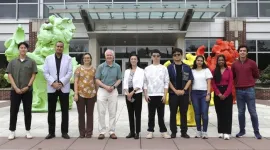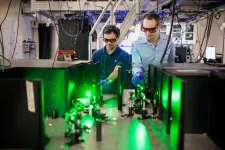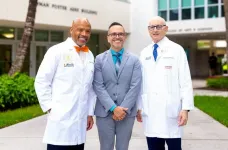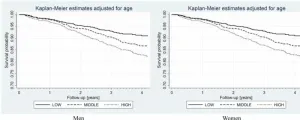(Press-News.org) Foreign animal diseases are a global threat to swine production with the potential for detrimental economic implications. Recently, researchers at the University of Illinois Urbana-Champaign received a three-year grant of $650,000 from the U.S. Department of Agriculture to develop sensitive, rapid, low-cost, and portable point-of-use biosensors to improve on-farm detection and surveillance of African swine fever virus.
ASFV is a large DNA virus that infects swine and can result in a lethal hemorrhagic fever, spread rapidly to neighboring pigs, and cause excessive morbidity and mortality in swine populations. There currently is no effective vaccine or treatment for ASFV to help prevent infection and transmission. Further, detection of the virus is challenging because it relies on expensive offsite laboratory-based methods which often take too long for successful disease mitigation.
“ASFV is very important right now because it is already a deadly disease in other countries, and it can kill pigs quickly, usually within 7 to 10 days,” said Ying Fang (CGD/MMG), a professor of pathobiology in the College of Veterinary Medicine. “For field surveillance, if we have a portable device, we can take it to the field, and quickly detect ASFV-infected pigs. In this way, we can immediately apply the control and prevention measures.”
With her expertise in animal diseases, Fang teamed up with Brian Cunningham (CGD leader), the Intel Alumni Endowed Chair of Electrical and Computer Engineering, to develop a biosensor for ASFV. Cunningham’s research focuses on developing nanotechnology-based biosensors for cancer and infectious diseases.
“We have been working on these technology approaches for about ten years, continuously refining and improving the biosensors, but mainly for cancer and infectious human diseases. So, when this USDA grant funding opportunity came up, Professor Fang encouraged us to try for it,” Cunningham said.
The project funding began on September 1 of this year, with the grant support coming from the USDA National Institute of Food and Agriculture’s Nanotechnology for Agriculture and Food Systems program. Over the next three years, the team will work on using genomics and proteomics to determine the diagnostic targets, specific viral nucleic acid sequences and proteins, for ASFV detection. Then, Fang’s research group will use their expert knowledge to develop and test laboratory-based methods for ASFV detection using this target. These methods will then be incorporated into Cunningham’s portable cartridge devices that use novel physics principles and nanotechnology methods to detect the target molecules from the virus.
The work done at Illinois will focus on gene and protein level detection because research with live ASFV requires specialized facilities to eliminate exposure and transmission. To test their novel biosensor with active ASFV, Fang and Cunningham will collaborate with Jishu Shi, a professor of vaccine immunology at Kansas State University which houses the necessary biosafety level 3 facilities.
Overall, this grant represents a new portfolio of research for the Center for Genomic Diagnostics theme at the Carl R. Woese Institute for Genomic Biology. “We have been focused exclusively on human health and diseases and the underlying engineering science for sensing them. This represents how we have really strong pathobiology and veterinary medicine, combined with innovative engineering, here at Illinois. I think alone, neither of us would be able to do this project, but together, we make an excellent team,” Cunningham said.
“I hope this collaboration sends signals out university-wide that veterinary medicine is also important and an area that needs to be emphasized. So, I'm hoping to have more of this kind of collaboration and to continue developing new technologies to apply to livestock animals and veterinary medicine,” Fang said.
END
Center for Genomic Diagnostics receives first USDA grant
2024-10-17
ELSE PRESS RELEASES FROM THIS DATE:
The National Tax Journal is pleased to announce the recipients of the 2024 Musgrave Prize and the 2024 Referee Award
2024-10-17
The National Tax Journal is pleased to announce the recipients of the 2024 Musgrave Prize and the 2024 Referee Award.
The Richard A. Musgrave Prize was created in 1999 and is presented each year to the author(s) of the best article published in the National Tax Journal. The award is a tribute to Richard Musgrave, whose work throughout his luminous career was characterized by a powerful blend of analytical clarity, insight drawn from the historical record, and respect for the importance of administrative issues. With this award, the National Tax Association recognizes his many contributions to public policy theory, research, and practice.
This year, ...
Study finds legalization didn’t increase recreational cannabis use among young adults in country of Georgia
2024-10-17
(Boston)—Cannabis is one of the most widely used drugs, with an estimated 219 million users globally in 2021, with the highest number of users in the Americas. It is also the most used drug among young people. In the U.S., cannabis use among young adults (age 19 to 22) reached a historically high level in 2021, with 42.6% reporting use in the past year.
Effects and impact of recreational cannabis legalization and decriminalization on societies is a topic of global relevance and increasing scientific interest. Despite a rapidly growing body of published evidence, findings remain mostly ...
A.J. Drexel Autism Institute study highlights key challenges and opportunities in transitioning autistic individuals into adulthood
2024-10-17
The Autism Transitions Research Project, funded by the Health Resources and Services Administration and led by Drexel University’s A.J. Drexel Autism Institute, has released new findings that underscore critical challenges and opportunities in transitioning autistic youth into adulthood. As approximately 1.2 million autistic individuals are expected to reach adulthood in the coming decade, these insights are vital for shaping future research and services.
The study, “Challenges and Opportunities in Transitioning Autistic Individuals into Adulthood,” led by Anne M. Roux, a research scientist and director at the Policy Impact Project in the ...
Measuring defects to better understand quantum systems
2024-10-17
Quantum defects have the potential to act as ultra-sensitive sensors that could offer new kinds of navigation or biological sensor technology.
One type of these defect systems, nitrogen vacancy (NV) centers in diamonds, can measure nanoscale magnetic fields. But while scientists can control the quantum spin of these centers — single defects in the diamond, where nitrogen has replaced the carbon — they still do not have a full understanding of how to best isolate that spin from the spins of other defects in the material, which can destroy its quantum state memory, ...
Repurposing drug shows promise in fighting aggressive brain tumours: uOttawa study
2024-10-17
Glioblastoma is the most common – and the most malignant – primary brain tumour in adults. It’s aggressive and incurable. Even with treatment including surgical removal and chemotherapy, the median survival for patients is just 18 months.
Now, innovative new research led by Dr. Arezu Jahani-Asl, Canada Research Chair in Neurobiology of Disease at the University of Ottawa, provides highly compelling evidence that a drug used to slow the progression of the disease ALS shows promise ...
New initiative to fuel neuroscience and aging research
2024-10-17
Demonstrating its commitment to excellence as a member of the Association of American Universities and number one in the state for National Institutes of Health (NIH) funding, the University of Miami has pledged to invest more than $30 million to bolster basic science research that will target neuroscience and aging, some of the most complex conditions confronting the United States population, including in South Florida.
The investment over the next five years will create a new program in ...
WashU researchers use genetics to find psychopathology risks
2024-10-17
When trying to understand how genetic influences factor into youth behavior, researchers at Washington University in St. Louis have taken the “big trawl” approach, casting their net wide to pull in all the measured traits, behaviors and environments that make up who we are and examine associations with the genetic building blocks comprising risk for mental health problems.
This cutting-edge methodology has turned up valuable new insights into factors related to psychopathological genetic risk, ...
Fibroblast growth factor 21 and survival in the elderly: Polsenior2 study results
2024-10-17
“Of note, participants with high serum levels of FGF21 more frequently had metabolic complications, such as hypertension, obesity, diabetes, hypercholesterolemia, and hypertriglyceridemia.”
BUFFALO, NY- October 17, 2024 – A new research paper was published in Aging (listed by MEDLINE/PubMed as "Aging (Albany NY)" and "Aging-US" by Web of Science), Volume 16, Issue 19 on September 18, 2024, entitled, “Fibroblast growth factor 21 inversely correlates with survival in elderly population – the results of the Polsenior2 study.”
As ...
Plankton balloon to six times their size in newly discovered mode of oceanic travel
2024-10-17
Many plankton journey from the cold, dark depths of our oceans to the surface, only to eventually drift down again into the darkness in a perpetual rhythm. Yet, how single-celled phytoplankton, most of which have no appendages to help them swim, make this pilgrimage has remained a mystery. In a paper publishing October 17 in the Cell Press journal Current Biology, researchers describe a species of bioluminescent phytoplankton, called Pyrocystis noctiluca, that balloons to six times their original size of a few hundred microns. This massive inflation allows the plankton to journey up to 200 meters toward the ocean’s surface to capture sunlight, then ...
Repurposing drugs to eliminate cellular origins of brain tumors
2024-10-17
Glioblastomas are aggressive brain tumors with a median survival time of less than 22 months despite standard therapy including surgery, irradiation, and chemotherapy. It has become clear in recent years that not all cells within the brain tumor have an equal potential to divide and drive tumor growth. As such, a fraction of tumor cells called brain tumor stem cells (BTSCs) are thought to be the primary origin of tumor re-growth after surgery in addition to being resistant to standard treatments including chemotherapy and irradiation. Therefore, targeting BTSCs may be a way to effectively treat glioblastomas.
In an effort to rapidly identify ...




